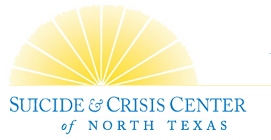For many, the holiday season brings parties, gifts, and fun with family and friends. But for some, the holidays can be stressful and depressing. The scary part is that often you don’t know who is struggling. Check out our online interview with Margie Wright, Executive Director, Suicide and Crisis Center of North Texas. Millions of people have been affected by suicide, and the more we talk about it, the better chance we have to save lives. Learn more about this widespread, yet taboo, issue and how you can make a difference.

MB. How long have you been working in suicide and emotional crisis prevention?
MW. I’ve been working at the Suicide and Crisis Center for more than fourteen years.
MB. What inspired you to work in this field?
MW. My background is in social work, and I had worked in other areas that dealt with people in crisis. I was invited to apply for the job and then, absolutely fell for the cause!
MB. According to a 2010 study by the CDC, 36,000 people kill themselves in the United States each year. What are some reasons behind this high number?
MW. Hopelessness and helplessness are the common thread in most suicides. Regardless of the other factors (like economic hardships and relationships), the driving force behind most suicides is the hopelessness. People feel that they can’t do anything about their situations. Most report psychological or emotional pain that they just want to stop. The term for this is “psych-ache,” coined by Dr. Schneidman who started the study of Suicidology.
MB. Who’s at risk?
MW. Those who are at highest risk are males, primarily older white males. We have seen a spike in suicides for men between 50 to 59 years old; however, Americans over age 60 still have the highest rates. Women make more suicide attempts, but men are much more likely to complete the suicide.
MB. Have you seen an increase in suicides amongst teenagers? If so, do you think that social media plays a role in this?
MW. Teenage suicide is also on the rise. And, I do think that social media can contribute, as well as other media. For example, some films tend to glamorize suicide.
MB. Is bullying a factor? If so, are there ways parents can intervene? What are those ways?
MW. Bullying can contribute to suicide, but there are always underlying causes to the suicide besides the bullying. Parents need to be aware of what their teens are doing, who they are spending time with, and who they are talking with online. Cyber-bullying is especially worrisome and somewhat prevalent. Parents need to spend lots of time interacting with their kids and attending to their emotional needs. This is a particularly vulnerable time.
MB. What should parents look out for?
MW. Parents should look out for changes in friends, a drop in grades, a lack of interest in school activities or other activities that previously interested the teen. It should especially alarm parents when a teen also withdraws from the family.
MB. I’ve read conflicting information regarding the fact that suicide and depression increase during the holidays? Can you set the record straight?
MW. More suicides actually happen in the spring. The holidays bring a great deal of depression, but suicides are more prevalent from March through May.
MB. What does the public need to know about suicide prevention?
MW. We need to work together. This is a community project. We can all help with preventing suicides by being more aware of the people around us and listening to them.
MB. What can someone do if they believe a person is suicidal?
MW. Ask the question! If you believe that someone is suicidal, you should just ask them.
MB. How can someone help a suicidal person that doesn’t want help?
MW. You can talk to them and keep encouraging them to get help. Tell them that you’re there for them, and make sure that others, who know the person, also know of your concerns.
MB. What is the grieving process for those whose loved ones have committed suicide? What do you recommend they do?
MW. The grieving process is a long one. I recommend that loved ones surround themselves with supportive people who will allow them to speak of the suicide in open terms. We have a Survivors of Suicide program that is very helpful with this. Some of the people attend our support groups and others do not. We provide reading material and also have supportive people who have experienced suicide loss for loved ones to talk to. We offer one-on-one postventions for individuals or families. This is not therapy, but it has a therapeutic effect, it is designed to relieve the distress felt by loved ones. A person having experienced such loss should reach out to programs similar to ours or find someone, a friend, therapist, minister, or a supportive person who will not judge during this difficult time.
MB. If someone is feeling suicidal right now, what should they do?
MW. Talk to someone you trust, and let them know how you are feeling. Letting someone know can be the best protection against acting on your thoughts. Be open to getting help. Allow others to help you. Think about the things that have kept you going in the past. Use these same coping skills that you used to deal with adversity again.
MB. What resources are out there for people who are contemplating suicide?
MW. People who are contemplating suicide can seek therapy, go to a hospital emergency room or check into a psychiatric hospital. If the need is immediate, people can call our 24 hour crisis line, 214-828-1000. There is also a National Talk Line, 1-800-273-TALK (8255) that people can call. Again, reaching out to friends, loved ones or medical staff and telling them how you are feeling is always the first step in helping to stop a suicide.
MB. Is there anything else that you would like our readers to know, to be more informed about suicide?
MW. Suicides are more prevalent in this country than homicides and now, more people are killed by suicide than in car accidents. Most of these are preventable.







Thank you Model Behaviors for this great frank talk about Suicide and this time of the year..
Thank you, Yvonne. You’re such a champion for this worthy cause. I am honored to help you spread awareness. And thank you for sharing your story. It takes bravery like yours to help make a difference.
T.